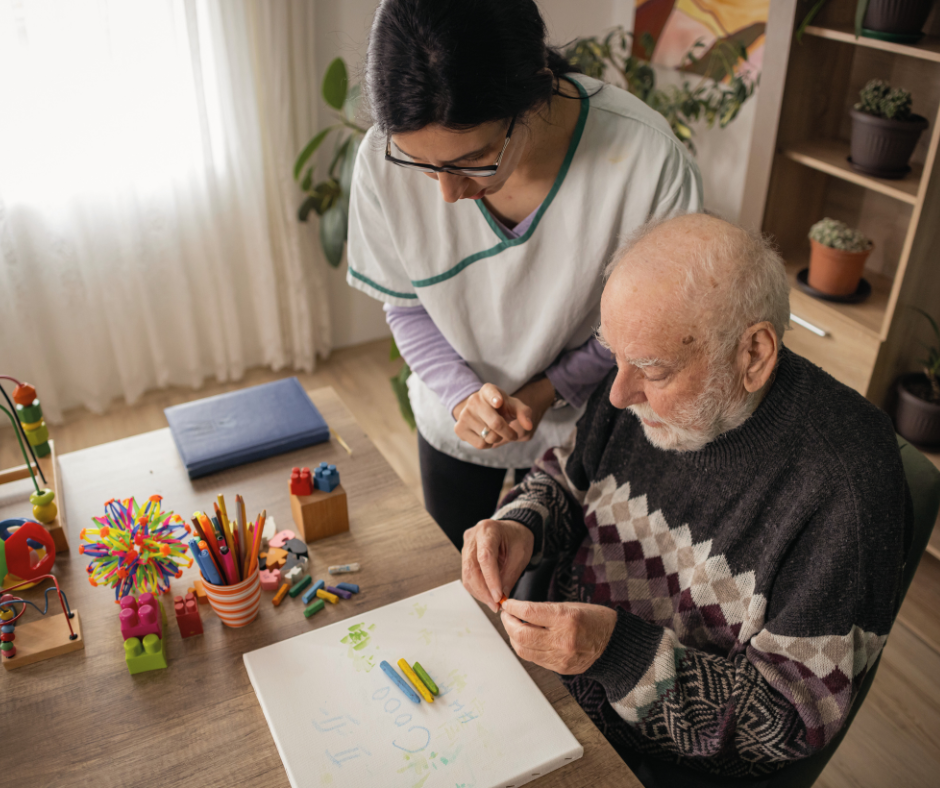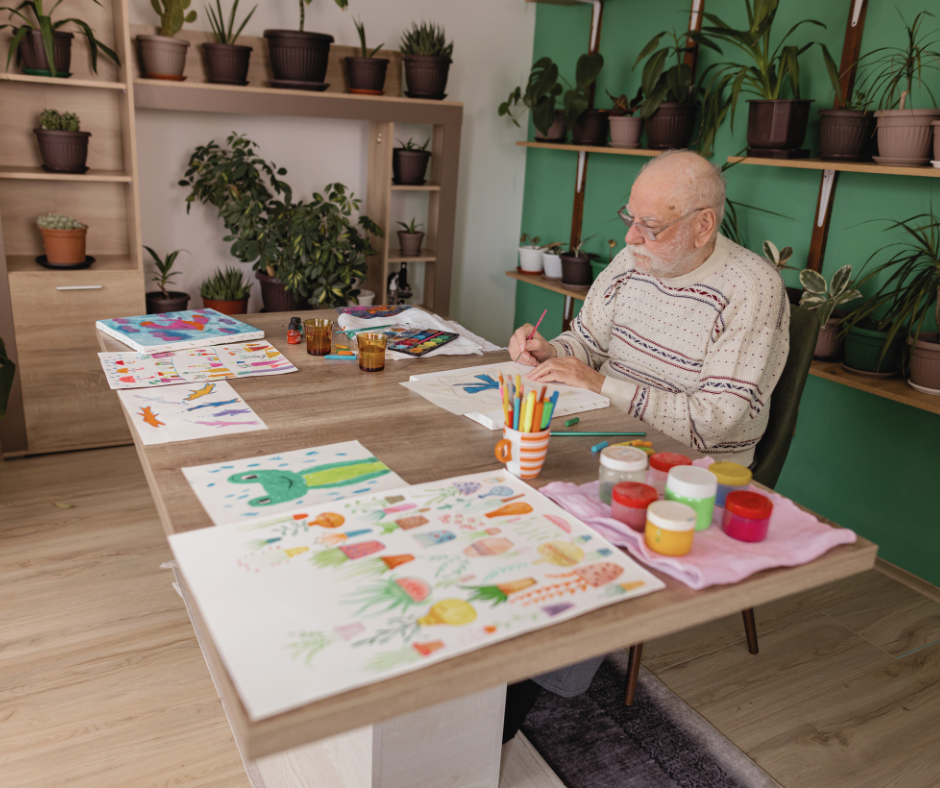

How to Become an Art Therapist
Summary
Reflection Questions
Journal Prompt
Art therapy, a form of psychotherapy, harnesses the creative process of art-making to improve and enhance the physical, mental, and emotional well-being of individuals. It integrates the fields of human development, visual arts, and the creative process with models of counseling and psychotherapy. Art therapists, trained in both therapy and art, use art as a medium to address emotional issues that may be confusing and distressing. They work in a variety of settings, including hospitals, schools, and private practices, assisting diverse client groups in overcoming challenges such as emotional trauma, psychological disorders, and social difficulties. In this article, we outline the steps to becoming a registered art therapist. If helping others and artistic expression are passions of yours, read on to learn more.
Educational Requirements Outlined by the American Art Therapy Association
The path to becoming an art therapist typically begins with a solid foundation in both psychology and visual arts. Prospective art therapists must generally complete a bachelor’s degree in a relevant field.
This is a prerequisite for entering accredited art therapy graduate programs, which are essential for professional practice. The educational journey intertwines an understanding of psychological theories and practices with a strong emphasis on artistic skills and creativity.
Recommended Undergraduate Courses or Majors
While no specific undergraduate major is mandated for future art therapists, majors in psychology, counseling, fine arts, or a related field are highly beneficial. Key courses to consider include developmental psychology, abnormal psychology, art history, and various art studio classes.
These courses lay the groundwork for understanding human behavior and expression, essential components of art therapy. Additionally, courses that foster personal artistic development are crucial, as art therapists must be adept in various art forms to effectively guide their clients.
Many allied health education programs offer interdisciplinary training that can be beneficial for art therapists. For example, courses in occupational therapy, counseling, psychology, and social work can provide foundational knowledge and skills that are applicable in art therapy. This interdisciplinary approach can enhance an art therapist’s ability to understand and address a wide range of client needs.
Graduate Programs in Art Therapy: What to Look for in an Art Therapy Degree


When selecting a graduate program in art therapy, accreditation by the American Art Therapy Association (AATA) is a critical factor. These programs typically offer a Master’s degree, combining coursework in psychological theory, human development, art therapy techniques, and supervised clinical experience.
Prospective students should look for programs that offer comprehensive training, including hands-on clinical practice. Schools known for their strong graduate art therapy programs include New York University, the School of the Art Institute of Chicago, and George Washington University.
These programs are recognized for their rigorous curriculum and experienced faculty, providing students with the knowledge and skills necessary for a career in art therapy.
Certification and Licensure


Certification in art therapy is a vital step in establishing oneself as a qualified professional in the field. After completing a recognized art therapy program, candidates must obtain the Art Therapist Registered (ATR) credential, administered by the Art Therapy Credentials Board (ATCB).
This involves submitting proof of educational qualifications and a certain number of supervised clinical hours. Following this, professionals can pursue the Board Certified Art Therapist (BCAT) credential, which requires passing a comprehensive examination. This certification process underscores a practitioner’s commitment to ethical standards and competence in art therapy practices.
State-by-State Licensure Requirements
Licensure requirements for art therapists vary significantly across states in the United States. Some states have specific licensure for art therapists, while others may require licensure under broader categories like professional counseling or marriage and family therapy.
These requirements generally include holding a master’s degree in art therapy or a related field, completing a set number of supervised clinical hours, and passing a state-recognized exam. Aspiring art therapists should consult the licensure board of their respective states to understand the specific criteria and processes for obtaining licensure.
They might also be required to complete a supervised art therapy internship under another qualified therapist before hosting their own unsupervised art therapy sessions and seeking full credentials. More on that later!
Continuing Education and Its Importance in the Field
Continuing education is crucial in art therapy for maintaining licensure and certification. Art therapists are expected to engage in ongoing learning to stay abreast of the latest developments in the field, including new therapeutic techniques, research findings, and ethical standards.
This commitment to continuous education ensures that practitioners can provide the highest quality of care to their clients. It often involves attending workshops, seminars, and conferences, and can also include undertaking advanced courses or training. By doing so, art therapists not only adhere to professional requirements but also foster personal and professional growth.
Skills and Qualities of an Effective Art Therapist
Interpersonal Skills
Interpersonal skills are paramount for art therapists, who must establish and maintain effective, trust-based relationships with their clients. This involves active listening, clear communication, and the ability to convey understanding and respect.
The art therapist’s role often extends to working collaboratively with other healthcare professionals, requiring strong teamwork and coordination skills. These interpersonal abilities facilitate a therapeutic environment conducive to client comfort and openness, essential for effective therapy.
Creative and Artistic Skills


Art therapists must possess a robust set of creative and artistic skills. Proficiency in various art forms, including drawing, painting, sculpting, and others, is essential, as these are the primary tools used in therapy.
This artistic proficiency allows therapists to guide clients in expressing themselves through art, often communicating emotions and thoughts that might be difficult to articulate verbally. The therapist’s own creativity also plays a role in developing innovative therapeutic strategies tailored to individual client needs.
Empathy and Patience
Empathy, the ability to understand and share the feelings of another, is a cornerstone of effective art therapy. This quality enables therapists to connect with clients on a deep level, fostering a supportive and validating therapeutic environment.
Alongside empathy, patience is critical, especially when working with clients who may be dealing with complex emotional issues. The therapeutic process can be gradual, requiring art therapists to exhibit patience and persistence, reassuring clients as they navigate their emotional journeys.
Problem-Solving and Adaptability


Problem-solving skills are vital in art therapy, where therapists often encounter diverse and complex client issues. The ability to think critically and develop effective, personalized therapeutic plans is key.
Equally important is adaptability—the capacity to adjust approaches and techniques in response to the evolving needs of clients. This flexibility ensures that therapy remains relevant and effective, adapting to each client’s unique circumstances and progress. Such adaptability also includes staying current with new therapeutic methods and research in the field.
Gaining Experience as an Art Therapist
Internship Opportunities and Their Importance
Internships are a crucial component of the journey to becoming an art therapist, providing invaluable hands-on experience. These opportunities allow aspiring art therapists to apply their academic knowledge in real-world settings under the supervision of experienced professionals.
Internships can be found in a variety of environments, such as hospitals, mental health clinics, and community centers. They offer a practical understanding of client interaction, therapy planning, and the nuances of working in different therapeutic contexts. This experiential learning is essential for developing clinical skills and professional competence.
Volunteer Work in Related Fields


Engaging in volunteer work in fields related to art therapy is another effective way to gain experience. Volunteering at community art programs, mental health organizations, or special needs facilities provides exposure to diverse populations and needs.
It not only enriches one’s understanding of the practical applications of art therapy but also demonstrates a commitment to the field. This experience is invaluable in developing empathy, communication skills, and a deeper understanding of the therapeutic process, all while contributing positively to the community.
Part-time Positions or Assistantships in Art Therapy Settings
Part-time positions or assistantships in art therapy settings offer a direct pathway to gaining relevant experience. These roles might involve assisting licensed art therapists in preparing materials, organizing sessions, and observing therapy practices.
Such positions provide a more structured and consistent exposure to the field compared to internships and volunteer work. They are particularly beneficial for developing specific art therapy skills, understanding the operational aspects of therapeutic settings, and building a professional network in the field.
Finding a Job as an Art Therapist


The job market for art therapists is evolving, influenced by an increasing recognition of the value of creative therapies in mental health and wellbeing. Opportunities in the art therapy profession exist across a range of settings. Many art therapists work in healthcare facilities, schools, community centers, and private practices.
The availability of art therapy jobs varies by region and is often influenced by public and private healthcare policies. Art therapists may also find niche opportunities in specialized areas such as trauma-informed care, working with specific populations like children or veterans, or in research roles. Understanding these dynamics is crucial for identifying potential job opportunities.
Tips for Job Searching and Networking
Effective job searching in the field of art therapy requires a combination of strategy and networking. Utilizing online job portals specific to art therapy and mental health is a good starting point. Joining professional organizations like the American Art Therapy Association can provide access to exclusive job listings and networking events.
Building a professional network through attending conferences, workshops, and local meetups can be invaluable. Networking allows for the sharing of information about unadvertised positions and can lead to meaningful professional relationships and mentorships.
Crafting an Effective Resume and Portfolio
A well-crafted resume and portfolio are essential tools for securing a job as an art therapist. The resume should highlight relevant education, certifications, and experience, focusing on specific skills and accomplishments in art therapy.
It is important to tailor the resume to the art therapy field, emphasizing experience with different therapeutic techniques and client populations. The portfolio, on the other hand, showcases the therapist’s artistic skills and therapeutic approach.
It should include a variety of art mediums and examples of client work (with confidentiality maintained), demonstrating the therapist’s ability to facilitate and engage in the creative process therapeutically. You might also choose to include references from other mental health professionals who are familiar with your work as a registered art therapist (ATR).
Specializations within Art Therapy
Art therapy offers the flexibility to specialize in working with various populations, each with unique needs and challenges. Specializing in children, for example, involves adapting techniques to suit their developmental stage and expressive abilities.
Working with veterans might focus on addressing post-traumatic stress disorder and reintegration into civilian life. Similarly, art therapists who specialize in geriatric care tailor their approach to the needs of the elderly, often focusing on cognitive preservation and emotional expression.
Each population requires a deep understanding of their specific psychological, social, and physical needs, guiding the art therapist in developing effective, tailored therapeutic interventions.
Various Therapeutic Approaches in Art Therapy
The field of art therapy encompasses a range of therapeutic approaches, each grounded in different psychological theories and techniques. Some therapists might employ a psychodynamic approach, focusing on unconscious processes expressed through art.
Others might use cognitive-behavioral techniques, where art activities are used to modify negative thought patterns and behaviors. Humanistic approaches, emphasizing self-exploration and personal growth through creative expression, are also common.
Understanding and training in these various approaches allow art therapists to adapt their art therapy materials and methods to best suit the needs of their clients. This makes each art therapy session more effective and individualized.
Opportunities for Advanced Specializations
Art therapists can pursue advanced specializations to deepen their expertise in certain areas of the field. These specializations can include trauma-informed art therapy, which focuses on working with individuals who have experienced traumatic events, or neurodevelopmental art therapy, tailored for clients with neurodiverse conditions such as autism.
Other specializations may involve using specific mediums (like digital art therapy) or integrating art therapy with other therapeutic modalities (like dance/movement therapy). Pursuing these advanced areas often involves additional training and education, and it can open up new professional opportunities, such as consulting, private practice, or specialized program development within institutions.
Challenges and Rewards of Being an Art Therapist
Common Challenges Faced in the Field
Art therapists often encounter a variety of challenges in their practice. These can include working with clients who are resistant or non-verbal, which requires patience and innovative therapeutic techniques. Navigating emotional responses from clients during therapy sessions can also be demanding.
Additionally, art therapists may face practical challenges such as limited resources or budget constraints, especially in underfunded settings. Balancing the administrative aspects of practice with clinical work adds another layer of complexity. These challenges require resilience, creativity, and a commitment to professional development.
Personal and Professional Rewards


Despite its challenges, a career in art therapy offers significant personal and professional rewards. One of the most fulfilling aspects is witnessing the positive impact of art therapy on clients’ lives, such as improvements in emotional expression, self-esteem, and coping skills. Art therapists often experience a sense of accomplishment and satisfaction from helping clients achieve personal breakthroughs.
Professionally, art therapists enjoy a dynamic and diverse career with opportunities for continual learning and creativity. The field’s collaborative nature also offers the chance to work with a variety of professionals and clients, enriching the therapist’s experience and perspective.
Final Thoughts on Becoming an Art Therapist
To become an art therapist, you must follow a dedicated path of education and training, starting with a relevant undergraduate degree, progressing through a specialized master’s program, and culminating in certification and licensure. Along this journey, developing a blend of interpersonal, creative, and therapeutic skills is essential.
Gaining experience through internships, volunteer work, and assistantships is invaluable, as is continuous professional development to stay abreast of advancements in the field. For those considering a career in art therapy, it is a profession that promises not only personal fulfillment but also the profound reward of making a significant difference in the lives of others.
The field of art therapy is dynamic and growing, offering diverse opportunities to impact various populations through the healing power of art. As we reflect on the role and significance of art therapy, it stands out as a unique and powerful tool in the realm of mental health and wellbeing, offering transformative experiences for both clients and therapists alike.








